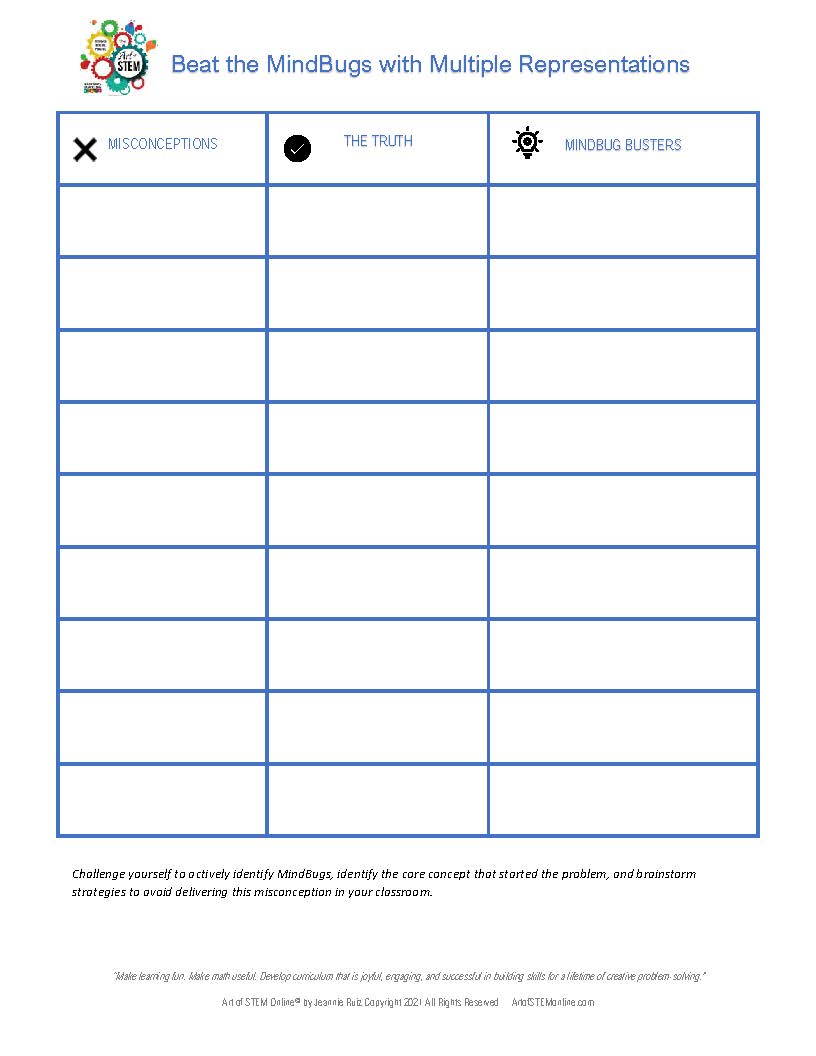Do You Have MindBugs?
MindBugs Are Misconceptions That Multiply
Misconceptions follow us into adulthood, and grown-ups carry a lot of MindBugs into our classrooms. All the little math tricks we were taught over decades of education can carry forward into misconceptions that hurt our students. MindBugs may start as cute tricks, but -like Star Trek Tribbles- MindBugs inside the learning system multiply until they are out of control.
What is a MindBug?
The MindBug is a mistaken idea that takes root early and grows out of control like a computer virus. Kurt VanLehn, a Carnegie Mellon Professor, fed a 4th grade textbook into a computer program and found that the computer made the same mistakes in later math as the children in classrooms. These “mindbugs” start as small misunderstandings that grow out of control and cause major malfunctions and systematic errors down the line. VanLehn developed a theory of learning to explain how students develop procedural misconceptions that cause errors in their learning systems. He called the errors MindBugs.




Why are misconceptions a problem?

Misconceptions often interfere with understanding and become subtle (and sometimes overt) obstacles to implementing the new practices in the classrooms. So why can’t we just tell older students to change the rule when it no longer works? It turns out that knowledge gained in early childhood is a lot harder to adjust as kids age.
A first grade teacher instructs students to line numbers up to the right before adding.

Lining Up to the Right Works for Awhile
What happens when 4th graders apply that rule to decimals? To 5th grade fractions? To algebraic equations in middle grades?
The addition rule rooted itself in the deep understanding of early learning, lodged itself firmly in the brain, and put out roots to other math concepts throughout the student’s learning system. What began as a single math rule gets distributed as new knowledge is acquired and catalogued, like a file copied from one folder to another. Eventually, rebooting the learning system to root out all instances of that simple original MindBug becomes too complicated to tackle. Math becomes “too hard,” and students decide that they just “don’t get it.”
Students Carry MindBugs into Adulthood

Nine big bad MindBugs about early learning were identified in adult educators based on in-depth interviews with early childhood teachers about key issues in mathematics education as well as researchers’ experiences. Researchers focused on experiences in teaching early childhood students, conducting workshops with early childhood teachers, working with teachers in early childhood classrooms, and engaging in informal conversations with participating teachers.*
Quick Self-Assessment: Do you identify with any of these statements?
- Young children are not ready for mathematics education.
- Mathematics is for some bright kids with mathematics genes.
- Simple numbers and shapes are enough.
- Language and literacy are more important than mathematics.
- Teachers should provide an enriched physical environment, step back, and let the children play.
- Mathematics should not be taught as stand-alone subject matter.
- Assessment in mathematics is irrelevant when it comes to young children.
- Children learn mathematics only by interacting with concrete objects.
- Computers are inappropriate for the teaching and learning of mathematics.

7 Cures for the Common MindBug
- Become aware of your personal biases.
- Discover student misconceptions before assuming you are all starting on the same page.
- Use multiple representations regularly to conquer your biases and shortcut theirs.
- Acknowledge multiple types of communication. The language of math cannot be taught with the same symbolic approach as the language of reading and writing. Math and science are performing arts that must be demonstrated.
- Consider expanding your classroom to include stations and breakout areas where students can discuss and collaborate to overcome misconceptions.
- Choose practice activities that use real measuring tools.
- Find lessons that do triple duty. Reinforce old skills while learning new.

Each of the examples in the image above offers practice for measurement, but these examples also reinforce estimation while introducing elapsed time and decimals. While we are obviously biased, all of our staff have successfully used MindBugs in Numeracy and MindBugs in Measurement for more than 20 years. Created for use in professional development (teaching triple duty and multiple representations), MindBugs activities were requested by teachers for use after PD in their own classrooms. We update them every few years, but they have stood the test of time. In a year of sporadic class time when we are all worried about maintaining skills, MindBugs have climbed back to the top of our lists.
Download the Free Worksheet and Sample MindBugs in Measurement
They are highly recommended by all of us at ArtofSTEM and our Partners Driving STEM at the InterNational STEM League.
Print the MindBugs in Early Learning Classrooms chart PLUS the three sample MindBugs Skill Builders shown below as a reminder to be aware of your own MindBugs and to address the misconceptions in your classroom. Share the printables with students in your physical classroom, or post them in a Google Classroom as measurement stations. Kids will need a measuring tape, a digital timer, and a kitchen scale to use these tools at home. Let us know how they work for you!




